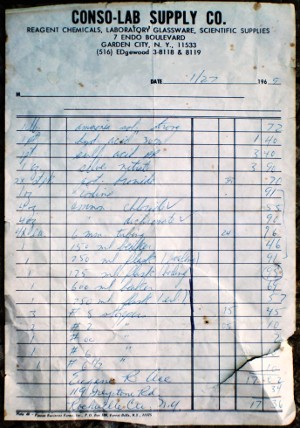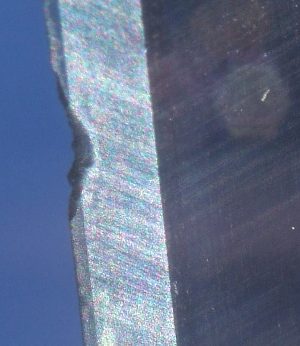Wednesday 28 Aug 2013 comment?
The middle part of Isaac Asimov's novel The Gods Themselves describes a race that mates in threes. I thought it was farfetched—two's company and three's a crowd—but hey, if quarks join in threes, why not aliens? The Gods Themselves was popular and won several awards.
The middle part of Isaac Asimov's novel The Gods Themselves describes a race that mates in threes. I thought it was farfetched—two's company and three's a crowd—but hey, if quarks join in threes, why not aliens? The Gods Themselves was popular and won several awards.
 I learned yesterday that the number three figures into the mating behavior
of a small lizard
(Uta stansburiana) common to my area. It's not like in
Asimov's novel where three join as one, but rather that the male lizards of
the species have three different color schemes, with lizards of each scheme
using different strategies for getting to entertain lady lizards.
I learned yesterday that the number three figures into the mating behavior
of a small lizard
(Uta stansburiana) common to my area. It's not like in
Asimov's novel where three join as one, but rather that the male lizards of
the species have three different color schemes, with lizards of each scheme
using different strategies for getting to entertain lady lizards.
The cool thing is, none of the three strategies is superior overall. It's like rock-paper-scissors: orange beats blue, blue beats yellow, and yellow beats orange. The orange- and blue-throated males are playing similar games, although the oranges are more aggressive; yellow-throated males are playing a sneaky game that lets them poach females from an orange-throated male's harem. As usual, Wikipedia has the details. It's said to be the first instance of a rock/paper/scissors-style game observed in nature. |
Sunday 25 Aug 2013 1 comment
Back in 1999, Oliver Sacks wrote an op-ed piece that appeared in the NY Times, "Hard Times for Curious Minds", recalling his childhood experiences with chemistry—and lamenting that kids no longer had the same opportunities for discovery and play because chemicals had gotten harder to obtain.
I'm younger than Oliver Sacks, but I'm old enough that interesting chemicals were not hard to come by when I was a kid.
Back in 1999, Oliver Sacks wrote an op-ed piece that appeared in the NY Times, "Hard Times for Curious Minds", recalling his childhood experiences with chemistry—and lamenting that kids no longer had the same opportunities for discovery and play because chemicals had gotten harder to obtain.
I'm younger than Oliver Sacks, but I'm old enough that interesting chemicals were not hard to come by when I was a kid.
 This receipt shows a bunch of chemicals my brother bought in 1969.
The first and sixth items are ingredients for making
nitrogen
triïodide, a contact explosive.
The eighth item is ammonium dichromate, bought for pyrotechnic purposes.
At this store you needed an adult to buy such things,
as evidenced by my dad's signature at the bottom.
I note that my dad understood chemistry and knew what all this was.
This receipt shows a bunch of chemicals my brother bought in 1969.
The first and sixth items are ingredients for making
nitrogen
triïodide, a contact explosive.
The eighth item is ammonium dichromate, bought for pyrotechnic purposes.
At this store you needed an adult to buy such things,
as evidenced by my dad's signature at the bottom.
I note that my dad understood chemistry and knew what all this was.
My brother and I survived childhood, although we did screw up from time to time. He forgot about a lump of sodium he'd left in a pail in our back yard, which gave my mom a thrill when she splashed water on it. I observed some less-than-optimal practices myself, like disposing of 70% nitric acid by pouring it down the sink. If chemicals were already getting harder to obtain by 1999, I can only imagine how much tighter the screws got after 9-11. I will leave to others the question of what the right level of regulation ought to be. But chemicals are not the only way to have fun. You can still buy capacitors, even if you're a kid. |
Friday 23 Aug 2013 comment?
About black locust (Robinia pseudoacacia), Wikipedia tells us, "The wood is extremely hard, resistant to rot and durable, making it prized for furniture, flooring, paneling, fence posts and small watercraft."
About black locust (Robinia pseudoacacia), Wikipedia tells us, "The wood is extremely hard, resistant to rot and durable, making it prized for furniture, flooring, paneling, fence posts and small watercraft."
 I cut down such
a tree earlier this year, dried a few pieces out for use as lumber,
and tried to machine some of it last week.
"Extremely hard" may be an understatement, in particular when a knot presents
end grain on the face of a board.
Of all the various types of wood I've run through planers,
Robinia is the first that absolutely destroyed the blades.
You might just as well try to plane rock.
I cut down such
a tree earlier this year, dried a few pieces out for use as lumber,
and tried to machine some of it last week.
"Extremely hard" may be an understatement, in particular when a knot presents
end grain on the face of a board.
Of all the various types of wood I've run through planers,
Robinia is the first that absolutely destroyed the blades.
You might just as well try to plane rock.
My dad once warned me about a kind of Murphy's Law with respect to thickness planers, that says you'll damage the blades by accidentally planing wood with a nail in it soon after putting new blades in a planer. Well. I've only once made that mistake, a few years ago, and it was in fact immediately after having installed new blades. But a nail put a smaller nick in the blade than black locust wood did. |
Thursday 22 Aug 2013 comment?
Horology was in the news today, to wit: advances in atomic clock technology said to achieve a stability of about one part in 1018.
Whereas "conventional" atomic clocks (e.g., the ones in GPS satellites) use atomic transitions associated with photons in the microwave frequency range, these new really-precise clocks are using larger energy changes associated with visual-light photons.
It takes some doing to precisely measure the frequency of visual light. The new clocks use a frequency comb to map the frequency down to the RF range first. I will not attempt a quick explanation of how that works.
If your clock is the most precise in the world, how do you know how accurate it is? I'm reminded of the first tests for HIV (well, HIV antibodies) in the mid-1980s. How accurate were they? Answering that question depended on having multiple types of test and some history of use.
Horology was in the news today, to wit: advances in atomic clock technology said to achieve a stability of about one part in 1018.
Whereas "conventional" atomic clocks (e.g., the ones in GPS satellites) use atomic transitions associated with photons in the microwave frequency range, these new really-precise clocks are using larger energy changes associated with visual-light photons.
It takes some doing to precisely measure the frequency of visual light. The new clocks use a frequency comb to map the frequency down to the RF range first. I will not attempt a quick explanation of how that works.
If your clock is the most precise in the world, how do you know how accurate it is? I'm reminded of the first tests for HIV (well, HIV antibodies) in the mid-1980s. How accurate were they? Answering that question depended on having multiple types of test and some history of use.
Saturday 03 Aug 2013 1 comment
Yesterday I found myself in prison with no idea why. I'd woken up from some kind of unconsciousness with no short-term memory. On opening my eyes I saw guards, I saw I was handcuffed, and I figured don't resist, that would only make things worse.
I asked what I was in for; they said murder. It's funny, but my first thought was, OK then, at least this isn't yet another dopey imprisonment resulting from the War on Drugs.
I was ushered to my cell, labeled M8. The cell was bigger than I expected and more pleasant: carpeted floor, nine-foot ceilings with acoustic tile. But I had a roomie and he talked too much. It took him a while to notice that I wasn't responding and thus probably wasn't interested in what he had to say, but at least he finally got the message.
After a while we were let out of the cell so we could hang out in a common area with televisions. I hate TV so I looked out the window instead. Nice view: rolling hills, trees, some rocks.
I found a brochure for the prison complex on a coffee table and started reading it. Four-color printing, thick glossy paper. The front cover had a picture of the grounds with the name of the prison, Cul-de-sac, written in a pretentious script typeface. I read some of the text inside the brochure that described the facility's considerable amenities while emphasizing that the security was nonetheless tough as nails.
I then noticed that the TV room was near the top of a staircase that led down to an exterior door. I went down the stairs and casually walked out. No one stopped me. I walked away from the building, not fast though because one of my legs hurt and I only had socks on my feet. I found someone who was headed for their car and asked if he could give me a ride. He said OK.
[ adapted from a dream I had 20 years ago ]
Yesterday I found myself in prison with no idea why. I'd woken up from some kind of unconsciousness with no short-term memory. On opening my eyes I saw guards, I saw I was handcuffed, and I figured don't resist, that would only make things worse.
I asked what I was in for; they said murder. It's funny, but my first thought was, OK then, at least this isn't yet another dopey imprisonment resulting from the War on Drugs.
I was ushered to my cell, labeled M8. The cell was bigger than I expected and more pleasant: carpeted floor, nine-foot ceilings with acoustic tile. But I had a roomie and he talked too much. It took him a while to notice that I wasn't responding and thus probably wasn't interested in what he had to say, but at least he finally got the message.
After a while we were let out of the cell so we could hang out in a common area with televisions. I hate TV so I looked out the window instead. Nice view: rolling hills, trees, some rocks.
I found a brochure for the prison complex on a coffee table and started reading it. Four-color printing, thick glossy paper. The front cover had a picture of the grounds with the name of the prison, Cul-de-sac, written in a pretentious script typeface. I read some of the text inside the brochure that described the facility's considerable amenities while emphasizing that the security was nonetheless tough as nails.
I then noticed that the TV room was near the top of a staircase that led down to an exterior door. I went down the stairs and casually walked out. No one stopped me. I walked away from the building, not fast though because one of my legs hurt and I only had socks on my feet. I found someone who was headed for their car and asked if he could give me a ride. He said OK.
[ adapted from a dream I had 20 years ago ]
current journal
FAQ
contact
rss/xml
atom/xml
spam notice
archive
FAQ
contact
rss/xml
atom/xml
spam notice
archive
| jan | feb | mar |
| apr | may | jun |
| jul | aug | sep |
| oct | nov | dec |
| jan | feb | mar |
| apr | may | jun |
| jul | aug | sep |
| oct | nov | dec |
| jan | feb | mar |
| apr | may | jun |
| jul | aug | sep |
| oct | nov | dec |
| jan | feb | mar |
| apr | may | jun |
| jul | aug | sep |
| oct | nov | dec |
| jan | feb | mar |
| apr | may | jun |
| jul | aug | sep |
| oct | nov | dec |
| jan | feb | mar |
| apr | may | jun |
| jul | aug | sep |
| oct | nov | dec |
| jan | feb | mar |
| apr | may | jun |
| jul | aug | sep |
| oct | nov | dec |
| jan | feb | mar |
| apr | may | jun |
| jul | aug | sep |
| oct | nov | dec |
| jan | feb | mar |
| apr | may | jun |
| jul | aug | sep |
| oct | nov | dec |
| jan | feb | mar |
| apr | may | jun |
| jul | aug | sep |
| oct | nov | dec |
| jan | feb | mar |
| apr | may | jun |
| jul | aug | sep |
| oct | nov | dec |
| jan | feb | mar |
| apr | may | jun |
| jul | aug | sep |
| oct | nov | dec |
| jan | feb | mar |
| apr | may | jun |
| jul | aug | sep |
| oct | nov | dec |
| jan | feb | mar |
| apr | may | jun |
| jul | aug | sep |
| oct | nov | dec |
| jan | feb | mar |
| apr | may | jun |
| jul | aug | sep |
| oct | nov | dec |
| jan | feb | mar |
| apr | may | jun |
| jul | aug | sep |
| oct | nov | dec |
| jan | feb | mar |
| apr | may | jun |
| jul | aug | sep |
| oct | nov | dec |
| jan | feb | mar |
| apr | may | jun |
| jul | aug | sep |
| oct | nov | dec |
| jan | feb | mar |
| apr | may | jun |
| jul | aug | sep |
| oct | nov | dec |
| jan | feb | mar |
| apr | may | jun |
| jul | aug | sep |
| oct | nov | dec |
| jan | feb | mar |
| apr | may | jun |
| jul | aug | sep |
| oct | nov | dec |
| jan | feb | mar |
| apr | may | jun |
| jul | aug | sep |
| oct | nov | dec |
| jan | feb | mar |
| apr | may | jun |
| jul | aug | sep |
| oct | nov | dec |

